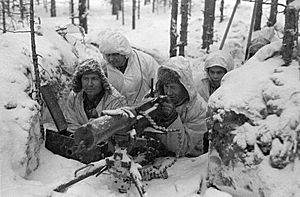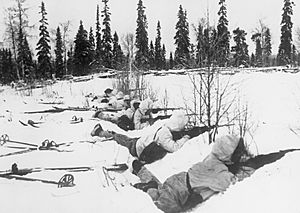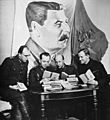Winter War facts for kids
Quick facts for kids Winter War |
|||||||
|---|---|---|---|---|---|---|---|
| Part of World War II | |||||||
 A Finnish machine gun crew during the Winter War |
|||||||
|
|||||||
| Belligerents | |||||||
Foreign volunteers |
|||||||
| Commanders and leaders | |||||||
| Strength | |||||||
| 337,000–346,500 men 32 tanks 114 aircraft |
425,640–760,578 men 3,880 aircraft |
||||||
| Casualties and losses | |||||||
| 25,904 dead or missing 43,557 wounded 1,000 captured 957 civilians in air raids 20–30 tanks 62 aircraft 70,000 total casualties |
126,875 dead or missing 188,671 wounded, injured or burned 5,572 captured 3,543 tanks 261–515 aircraft 323,000 total casualties |
||||||
The Winter War was a conflict between the Soviet Union and Finland. It lasted from November 30, 1939, to March 13, 1940. The war started when the Soviet Union tried to invade Finland. This happened shortly after the invasion of Poland.
The Soviet army was much larger and had more tanks and planes. They expected to win against Finland very quickly, perhaps in just a few weeks. However, the Finnish soldiers fought back much better and longer than expected.
One big reason for Finland's strong defense was their winter gear. Finnish soldiers wore white coats that helped them blend into the snow. They also used skis to move quietly and quickly. This made it easy for them to surprise Soviet soldiers. In contrast, the Soviet army had dark green coats, which made them easy to spot in the snow. They also struggled with the harsh winter conditions.
Even though Finland fought bravely, they eventually lost the war. They had to give up about 11% of their land to the Soviet Union. Finland later tried to get these areas back during the Continuation War.
Contents
Why the War Started
The Soviet Union wanted to move its border with Finland further away from Leningrad (now Saint Petersburg). Leningrad was a very important Soviet city. The Soviets worried that Finland could be used as a base to attack Leningrad.
They asked Finland to give up some land and islands. Finland refused to give up all the land the Soviets wanted. This disagreement led to the Soviet Union attacking Finland.
How Finland Fought Back
Finland was a small country, but its soldiers were very skilled. They used the cold, snowy forests to their advantage. They were good at camouflage and moving silently on skis.
The Finnish army also used a tactic called Motti. This involved surrounding small groups of enemy soldiers. Once surrounded, these groups were cut off from supplies and help. This made it easier for the Finns to defeat larger Soviet forces.
The End of the War
The Winter War ended with the Interim Peace treaty. Finland had to give up several areas to the Soviet Union. These included parts of the Karelian Isthmus, Ladoga Karelia, and some islands. They also had to let the Soviet Union rent the Hanko peninsula.
Even though Finland lost land, many people around the world admired their brave fight. The war showed that a smaller country could stand up to a much larger power.
Related pages
Images for kids
-
The non-aggression pact signed by Aarno Yrjö-Koskinen and Maxim Litvinov, Moscow, 1932
-
29 November 1939, foreign press at Mainila, where a border incident between Finland and the Soviet Union escalated into the Winter War
-
Soviet T-26 Model 1937 "advancing aggressively", as described by the photographer, on the eastern side of Kollaa River during the battle of Kollaa
-
Soviet prisoners of war dressed with new clothes near the Arctic Circle at Rovaniemi in January 1940
-
Soviet commander Semyon Timoshenko in 1940
See also
 In Spanish: Guerra de Invierno para niños
In Spanish: Guerra de Invierno para niños















